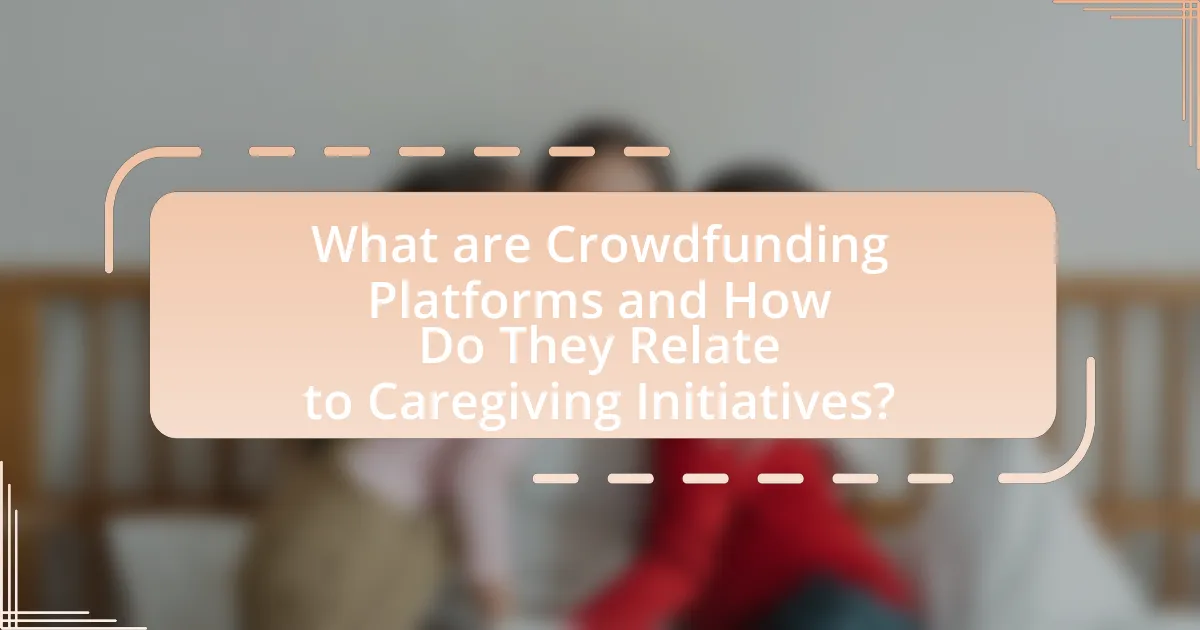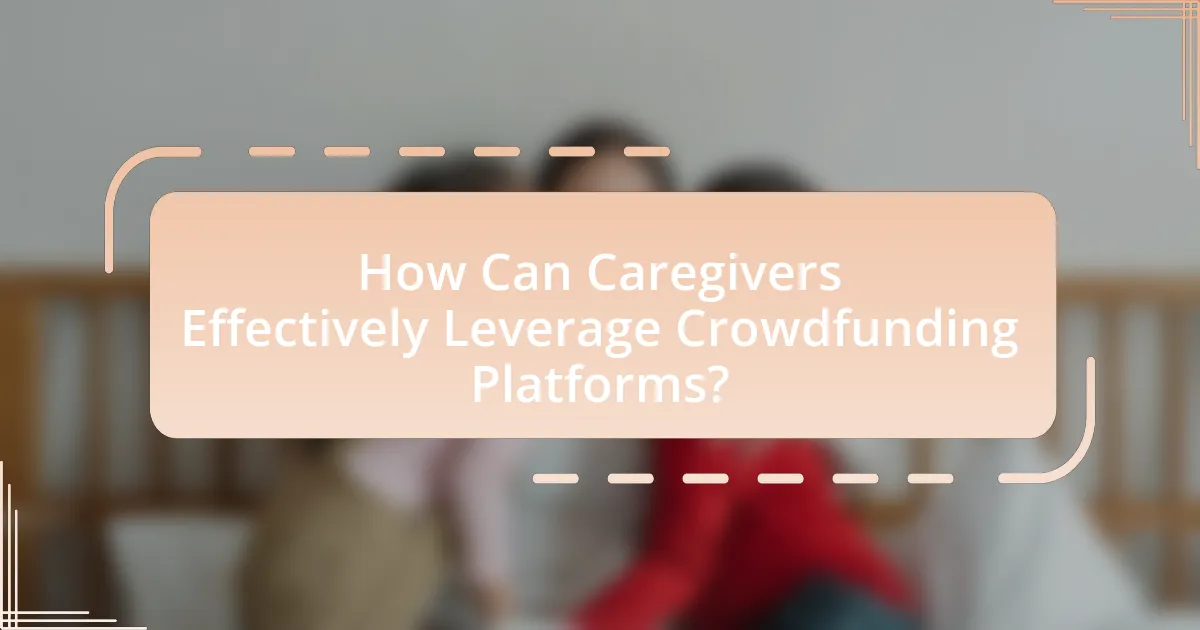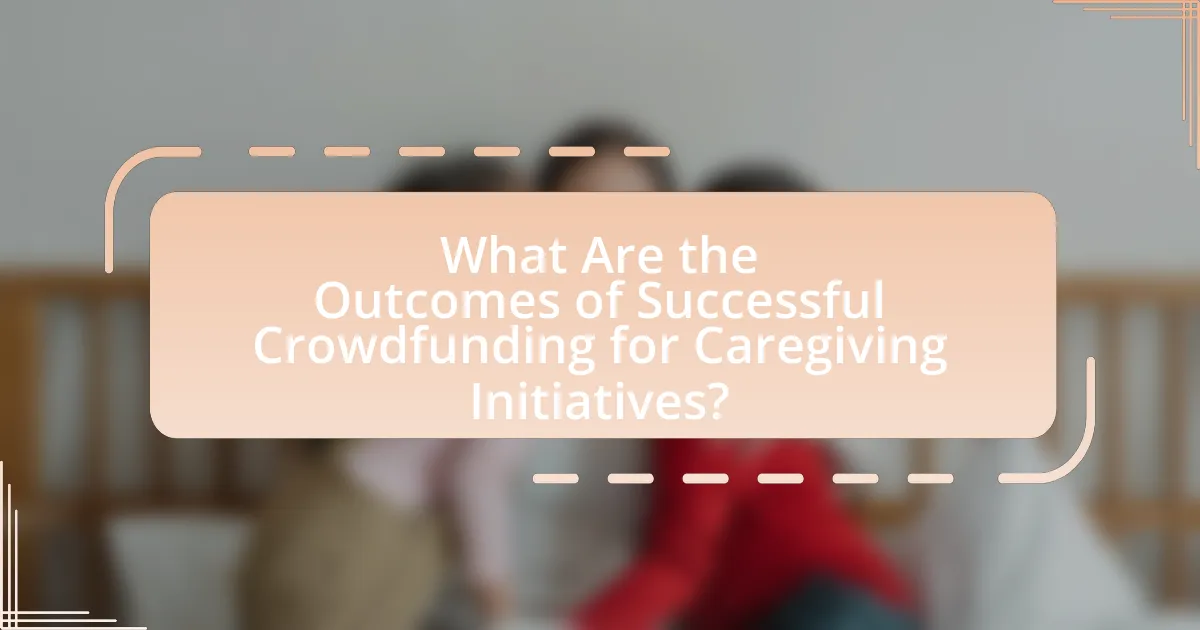Crowdfunding platforms are online services that enable individuals and organizations to raise funds from a large audience, particularly for caregiving initiatives. These platforms, including donation-based and reward-based options, provide essential financial support for caregivers facing medical expenses and resource needs. The article explores various types of crowdfunding platforms, their functionalities, and their significance in enhancing caregiving efforts. It also addresses strategies for successful campaigns, common challenges caregivers encounter, and the long-term benefits of effective crowdfunding, ultimately highlighting the impact of successful fundraising on the caregiving community.

What are Crowdfunding Platforms and How Do They Relate to Caregiving Initiatives?
Crowdfunding platforms are online services that allow individuals or organizations to raise funds from a large number of people, typically through small contributions. These platforms relate to caregiving initiatives by providing a means for caregivers and families to gather financial support for medical expenses, caregiving resources, or community projects aimed at improving care for individuals in need. For instance, according to a 2021 study published in the Journal of Medical Internet Research, crowdfunding has become a significant source of funding for healthcare-related expenses, with platforms like GoFundMe facilitating millions of dollars in donations for caregiving-related causes.
What types of crowdfunding platforms are available for caregiving initiatives?
There are several types of crowdfunding platforms available for caregiving initiatives, including donation-based, reward-based, equity-based, and debt-based crowdfunding. Donation-based platforms, such as GoFundMe, allow individuals to raise funds for personal caregiving needs without offering anything in return. Reward-based platforms, like Kickstarter, enable caregivers to offer small rewards or incentives to backers in exchange for their support. Equity-based crowdfunding, exemplified by platforms like SeedInvest, allows caregivers to offer shares in a business or initiative in exchange for funding. Lastly, debt-based crowdfunding, such as LendingClub, involves borrowing funds that must be repaid with interest. Each type serves different needs and goals within the caregiving sector.
How do donation-based crowdfunding platforms function?
Donation-based crowdfunding platforms function by allowing individuals or organizations to create campaigns where they solicit financial contributions from the public to support specific causes or projects. These platforms typically provide a user-friendly interface for campaign creators to present their stories, set funding goals, and share updates, while donors can easily browse campaigns, contribute funds, and often share the campaigns within their networks to increase visibility. According to a report by Statista, in 2021, the global crowdfunding market was valued at approximately $13.9 billion, highlighting the significant role these platforms play in facilitating donations for various initiatives.
What are the features of reward-based crowdfunding platforms?
Reward-based crowdfunding platforms primarily feature tiered reward systems, allowing backers to receive specific incentives based on their contribution levels. These platforms typically include project visibility tools, enabling creators to showcase their campaigns through engaging media and updates, which helps attract potential backers. Additionally, they often provide social sharing capabilities, allowing users to promote campaigns across various social media channels, thereby increasing reach and engagement.
Moreover, reward-based crowdfunding platforms usually incorporate secure payment processing systems to facilitate transactions, ensuring that funds are collected efficiently and safely. They also offer analytics and reporting tools, which help project creators track funding progress and backer engagement, allowing for data-driven adjustments to their campaigns. These features collectively enhance the effectiveness of fundraising efforts, making reward-based crowdfunding a popular choice for creators seeking financial support for their initiatives.
Why are crowdfunding platforms important for caregiving initiatives?
Crowdfunding platforms are important for caregiving initiatives because they provide a vital source of financial support that can be accessed quickly and efficiently. These platforms enable individuals and organizations to raise funds directly from a large number of people, which is particularly beneficial for caregiving projects that may lack traditional funding sources. For instance, according to a study by the University of California, Berkeley, crowdfunding has been shown to increase the likelihood of funding success for healthcare-related initiatives by 30% compared to conventional fundraising methods. This accessibility allows caregivers to gather necessary resources for medical expenses, equipment, or support services, ultimately enhancing the quality of care provided to those in need.
How do they provide financial support for caregivers?
Crowdfunding platforms provide financial support for caregivers by enabling individuals to raise funds through online campaigns. These platforms allow caregivers to share their stories and specific needs, attracting donations from friends, family, and even strangers who empathize with their situation. For instance, GoFundMe reported that over $9 billion has been raised for various causes, including caregiving, demonstrating the effectiveness of this method in securing financial assistance. Additionally, platforms often offer tools for campaign promotion and community engagement, further enhancing the potential for successful fundraising.
What role do they play in raising awareness for caregiving issues?
Crowdfunding platforms play a crucial role in raising awareness for caregiving issues by providing a space for individuals and organizations to share personal stories and funding needs related to caregiving. These platforms amplify the voices of caregivers and those they support, making their challenges visible to a broader audience. For instance, campaigns on platforms like GoFundMe often highlight specific caregiving situations, drawing attention to the emotional and financial burdens faced by caregivers. This visibility can lead to increased public discourse, advocacy efforts, and potential policy changes aimed at improving support for caregivers.

How Can Caregivers Effectively Leverage Crowdfunding Platforms?
Caregivers can effectively leverage crowdfunding platforms by creating compelling narratives that highlight the specific needs and challenges faced in their caregiving roles. This approach engages potential donors emotionally and encourages them to contribute. Research indicates that campaigns with personal stories and clear financial goals raise 50% more funds than those without. Additionally, caregivers should utilize social media to promote their crowdfunding efforts, as platforms like Facebook and Twitter can significantly increase visibility and reach. Engaging with the community through updates and expressing gratitude can also foster a supportive environment, leading to sustained contributions.
What strategies can caregivers use to create successful crowdfunding campaigns?
Caregivers can create successful crowdfunding campaigns by clearly defining their goals, sharing compelling personal stories, and leveraging social media for outreach. Clearly defined goals help potential donors understand the purpose and urgency of the campaign, increasing the likelihood of contributions. Personal stories resonate emotionally with potential backers, making them more inclined to support the cause. Additionally, utilizing social media platforms can amplify the campaign’s reach, as studies show that campaigns promoted through social networks can raise up to 50% more funds than those that are not. Engaging visuals and regular updates also keep supporters informed and invested in the campaign’s progress, further enhancing its success.
How can storytelling enhance a crowdfunding campaign?
Storytelling can enhance a crowdfunding campaign by creating an emotional connection between the campaigner and potential backers. This emotional engagement increases the likelihood of support, as narratives that resonate with personal experiences or societal issues can motivate individuals to contribute. Research indicates that campaigns with compelling stories raise 30% more funds than those without a narrative element, demonstrating the effectiveness of storytelling in capturing attention and fostering empathy. By illustrating the impact of the initiative through relatable anecdotes, campaigners can effectively communicate their mission and inspire action among supporters.
What are the best practices for setting funding goals?
The best practices for setting funding goals include defining a clear and specific target amount, understanding the costs associated with the initiative, and aligning the goals with the audience’s capacity to contribute. Clear targets help potential backers understand the financial needs of the project, while a thorough understanding of costs ensures that the funding goal is realistic and achievable. Additionally, research indicates that campaigns with specific funding goals tend to perform better; for instance, a study by Indiegogo found that campaigns with defined goals raised 20% more than those without. Engaging with the community to gauge their willingness to support the initiative also enhances the likelihood of meeting funding goals.
What are common challenges caregivers face when using crowdfunding?
Caregivers commonly face challenges such as lack of visibility, emotional stress, and platform fees when using crowdfunding. Lack of visibility can hinder fundraising efforts, as many caregivers struggle to reach a broad audience, limiting donations. Emotional stress arises from the dual burden of caregiving responsibilities and the pressure to successfully fundraise, which can lead to burnout. Additionally, platform fees can reduce the total amount received, as many crowdfunding sites charge a percentage of the funds raised, impacting the financial support caregivers ultimately receive. These challenges can significantly affect the effectiveness of crowdfunding as a financial resource for caregiving initiatives.
How can caregivers overcome skepticism from potential donors?
Caregivers can overcome skepticism from potential donors by providing transparent information about their initiatives and demonstrating the impact of their work. Transparency builds trust; for instance, sharing detailed budgets and progress reports can show donors exactly how their contributions will be utilized. Additionally, showcasing testimonials and success stories from beneficiaries can illustrate the effectiveness of the caregiving initiatives, reinforcing credibility. Research indicates that 70% of donors are more likely to contribute when they see clear evidence of positive outcomes, highlighting the importance of effective communication in fundraising efforts.
What steps can be taken to maintain donor engagement throughout the campaign?
To maintain donor engagement throughout the campaign, organizations should implement regular communication, personalized updates, and acknowledgment of contributions. Regular communication, such as weekly newsletters or social media updates, keeps donors informed about campaign progress and impact. Personalized updates, tailored to individual donor interests, enhance the connection between the donor and the cause. Acknowledging contributions through thank-you messages or public recognition fosters a sense of appreciation and encourages ongoing support. Research indicates that campaigns with consistent donor engagement strategies see a 20% increase in repeat donations, highlighting the effectiveness of these steps in sustaining donor interest and commitment.

What Are the Outcomes of Successful Crowdfunding for Caregiving Initiatives?
Successful crowdfunding for caregiving initiatives typically results in increased financial support, enhanced community engagement, and improved access to necessary resources. Financially, successful campaigns can raise significant funds, enabling caregivers to cover medical expenses, purchase equipment, or afford respite care. For instance, a study by the University of California found that crowdfunding campaigns for medical expenses raised an average of $7,000, demonstrating the financial impact on caregiving. Community engagement is fostered as supporters rally around a cause, creating networks of assistance and emotional support for caregivers. Additionally, successful crowdfunding can lead to greater awareness of caregiving challenges, prompting discussions and potential policy changes to improve support systems for caregivers.
How does successful crowdfunding impact the caregiving community?
Successful crowdfunding significantly enhances the caregiving community by providing essential financial resources for caregivers and their initiatives. This influx of funds allows caregivers to access necessary tools, services, and support systems that improve the quality of care they can provide. For instance, a study by the Stanford Social Innovation Review found that crowdfunding campaigns for health-related causes raised over $1 billion in 2018 alone, demonstrating the financial viability and community support for caregiving initiatives. Additionally, successful campaigns foster a sense of community and shared purpose, encouraging collaboration among caregivers and stakeholders, which ultimately leads to improved caregiving outcomes.
What are the long-term benefits for caregivers who successfully fund their initiatives?
Caregivers who successfully fund their initiatives experience long-term benefits such as enhanced financial stability, improved service quality, and increased community support. Financial stability allows caregivers to allocate resources effectively, ensuring sustainability in their caregiving efforts. Improved service quality results from the ability to invest in better tools, training, and support systems, which directly enhances the care provided to individuals. Additionally, increased community support fosters a network of collaboration and shared resources, leading to a more robust caregiving environment. Research indicates that funded initiatives often lead to higher satisfaction rates among caregivers and those they serve, reinforcing the positive impact of successful funding on long-term caregiving outcomes.
How can successful campaigns inspire others in the caregiving field?
Successful campaigns can inspire others in the caregiving field by demonstrating effective strategies for fundraising and community engagement. For instance, campaigns that showcase personal stories and tangible outcomes often resonate deeply, motivating others to replicate similar approaches. A notable example is the “GoFundMe” campaign for a caregiver’s medical expenses, which raised over $100,000, illustrating the power of storytelling in garnering support. This success not only highlights the potential of crowdfunding but also encourages other caregivers to share their narratives, fostering a culture of support and innovation within the caregiving community.
What lessons can be learned from unsuccessful crowdfunding attempts?
Unsuccessful crowdfunding attempts reveal critical lessons about project planning, audience engagement, and marketing strategies. Firstly, inadequate preparation often leads to failure; projects lacking a clear value proposition or realistic funding goals struggle to attract backers. For instance, a study by Indiegogo found that campaigns with well-defined goals raised 50% more than those without. Secondly, understanding the target audience is essential; campaigns that fail to resonate with potential supporters often fall short. Research indicates that campaigns with tailored messaging to specific demographics see higher success rates. Lastly, effective marketing is crucial; projects that do not utilize social media or community outreach miss opportunities for visibility. According to Kickstarter data, campaigns that actively engage with their audience through updates and promotions are 20% more likely to succeed. These insights underscore the importance of thorough planning, audience awareness, and strategic marketing in crowdfunding initiatives.
What factors contribute to the failure of crowdfunding campaigns in caregiving?
The failure of crowdfunding campaigns in caregiving is primarily attributed to inadequate marketing and outreach efforts. Many campaigns lack a clear strategy to engage potential donors, resulting in low visibility and support. Additionally, unrealistic funding goals can deter contributions, as backers may perceive them as unattainable. A study by the University of California found that campaigns with well-defined goals and effective communication strategies raised 30% more funds than those without. Furthermore, emotional storytelling is crucial; campaigns that fail to connect on a personal level often struggle to resonate with potential supporters. These factors collectively contribute to the high failure rate of crowdfunding initiatives in the caregiving sector.
How can these lessons inform future crowdfunding efforts?
Lessons from previous crowdfunding efforts can inform future initiatives by highlighting the importance of clear communication and community engagement. Successful campaigns often demonstrate that transparent storytelling about the cause and its impact significantly increases donor trust and participation. For instance, a study by the University of Pennsylvania found that campaigns with compelling narratives raised 50% more funds than those lacking emotional appeal. Additionally, leveraging social media for outreach has proven effective; campaigns that utilized platforms like Facebook and Twitter saw a 30% increase in backer engagement. These insights suggest that future crowdfunding efforts should prioritize authentic communication and strategic use of social media to enhance visibility and support.
What practical tips can caregivers follow to maximize their crowdfunding success?
Caregivers can maximize their crowdfunding success by creating a compelling narrative that clearly outlines their needs and the impact of donations. A well-crafted story engages potential donors emotionally, increasing the likelihood of contributions. Additionally, caregivers should utilize social media platforms to share their campaigns widely, as studies show that campaigns promoted through social media can raise up to 50% more funds than those that are not. Regular updates on the crowdfunding page keep supporters informed and invested in the journey, fostering a sense of community and encouraging further donations. Lastly, offering tangible rewards or recognition for donors can incentivize contributions, as research indicates that campaigns with donor incentives tend to perform better.
How can caregivers effectively promote their campaigns on social media?
Caregivers can effectively promote their campaigns on social media by utilizing targeted content strategies, engaging visuals, and community interaction. By creating compelling narratives around their caregiving experiences and the impact of their campaigns, caregivers can resonate with their audience. Engaging visuals, such as photos and videos, can enhance emotional connection and increase shareability. Additionally, actively interacting with followers through comments, shares, and live sessions fosters a sense of community and encourages support. Research indicates that campaigns with strong visual elements and personal storytelling can increase engagement rates by up to 650%, demonstrating the effectiveness of these strategies in social media promotion.
What resources are available to assist caregivers in their crowdfunding efforts?
Caregivers can access various resources to assist in their crowdfunding efforts, including specialized crowdfunding platforms, educational materials, and community support networks. Platforms like GoFundMe and GiveForward cater specifically to personal causes, allowing caregivers to create campaigns tailored to their needs. Additionally, many organizations provide guides and tips on effective fundraising strategies, such as storytelling techniques and social media promotion, which can enhance campaign visibility. Community support networks, including local caregiver support groups, can also offer advice and share successful fundraising experiences, further empowering caregivers in their crowdfunding initiatives.